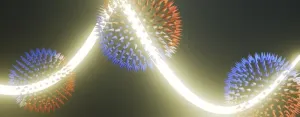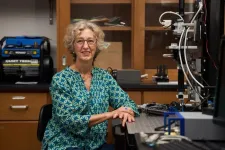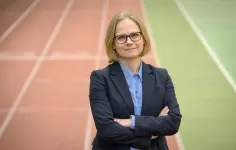(Press-News.org) In traditional electronics, information is transferred using the charge of electrons. However, future technologies may rely on a different property of electrons—their intrinsic angular momentum. Historically, the focus has been on electron spin, a form of build-in angular momentum that creates a magnetic moment, as the leading candidate for next-generation devices. Now, researchers are exploring the potential of orbitronics, a field that utilizes the angular momentum of electrons generated as they orbit the atomic nucleus. Orbitronics holds great promise for memory devices, particularly because it could generate large magnetizations with small charge currents, leading to energy-efficient technology.
A critical challenge in orbitronics has been identifying the right materials to generate large orbital polarizations. Recent advances have made progress using conventional materials like titanium. However, chiral materials, which often have a unique helical atomic structure similar to the DNA double helix, offer an exciting alternative. These materials naturally possess OAM textures as an intrinsic property, making them particularly attractive for orbitronics.
“This offers a significant advantage to other materials because it means you don’t need to apply external stimuli to get orbital textures – they’re just there,” explains Dr. Niels Schröter, an independent group leader at the Max Planck Institute of Microstructure Physics, who led the study. “This gives them the potential to be really stable.”
The perfect solution for orbitronics: spiky hedgehogs
Another unusual and advantageous feature of such materials is their potential to host monopoles of OAMs within their electronic band structures. In this scenario, OAM behaves in ways that defy the rules of symmetry seen in conventional systems. For example, in magnets, we expect a north and south pole, rather than an isolated monopole.
At these monopoles, OAM radiates outwards like the spikes of a scared hedgehog curled into a ball. And this is what makes these materials so attractive: OAM is uniform in all directions – i.e. it is isotropic.
“This is a very useful property as it means flows of OAMs could be generated in any direction,” says Dr. Jonas Krieger, formerly a Postdoc at the Max Planck Institute of Microstructure Physics, who led the experimental team that made the discovery. Dr. Krieger is now a tenure-track scientist at the Paul Scherrer Institute in Switzerland where he still closely collaborates with his colleagues from Germany.
But where are they hiding?
OAM monopoles in chiral crystals have long been an exciting prospect for orbitronics, but until now, they had only existed in theory. Observing them experimentally has been a significant challenge. The key to unlocking this mystery lay in a technique called Circular Dichroism in Angle-Resolved Photoemission Spectroscopy, or CD-ARPES, which uses X-rays from a synchrotron light source. Despite its potential, previous attempts to detect OAM monopoles with this method had been unsuccessful.
“There was a disconnect between theory and experiment. Researchers may have collected the right data, but the evidence for OAM monopoles was hidden within it,” explains Dr. Schröter.
The difficulty stemmed from interpreting the complex data generated by CD-ARPES. In this technique, light is shone onto a material, ejecting electrons. The angles and energies of these ejected electrons provide insights into the material's electronic structure. When circularly polarized light is used, it was initially assumed that the measurements would directly reflect the OAMs.
“That assumption turned out to be too simplistic. Our study revealed that the reality is much more complicated,” says Dr. Michael Schüler from the Paul Scherrer Institute, who supervised the development of theoretical models that were used to interpret the data.
Rigour plugs the gap
Determined to untangle the complex web of CD-ARPES data to reveal the existence of OAM monopoles, Schröter, Krieger, Schüler and colleagues examined two types of chiral crystals: those made of palladium and gallium or platinum and gallium, which were synthesized at the Max Planck Institute for Chemical Physics in Dresden in the Group of Prof. Claudia Felser.
The team approached the puzzle with an open mind to challenge every assumption. They then made an unusual extra step of performing the experiments at various photon energies. “At first, the data didn’t make sense. The signal seemed to be changing all over the place,” says Krieger.
By carefully comparing the experimental data to theoretical models, the scientists unpicked how different contributions complicated calculations of OAM from CD-ARPES data. In this way, they demonstrated how the CD-ARPES signal was not directly proportional to the OAMs, as previously believed, but rotated around the monopoles as the photon energy was changed. The theoretical model that they finally built fitted the CD-ARPES data regardless of the crystal orientation or photon energy tested.
In this way, they proved the presence of OAM monopoles. “The smoking-gun was robustness,” explains Schröter. “Certain features persisted no matter which conditions we used. The only way to have this is with OAM monopoles, where the OAM is isotropic.”
Armed with the ability to accurately visualise OAM monopoles, Schröter and colleagues went on to show that the polarity of the monopole - whether the spikes of OAMs point inwards or outwards - could be reversed by using a crystal with a mirror image chirality. “This is a very useful property, since it tells us that we control the directionality of the orbital response to external stimuli via the handedness of the crystal structure,” says Schröter.
Looking Ahead: The Center for Chiral Electronics
This discovery not only marks a significant milestone in orbitronics but also aligns with the goals of the newly proposed Center for Chiral Electronics, a joint initiative between the Max Planck Institute of Microstructure Physics and the universities in Halle, Berlin, and Regensburg. The Center aims to address the growing need for more efficient data storage and processing technologies. By exploring the unique properties of chirality in electronic applications, the Center will develop new devices with advanced functionalities.
Text: Adapted from Paul Scherrer Institute / Miriam Arrell
END
Discovery of orbital angular momentum monopoles enables orbital electronics with chiral materials
Orbital angular momentum monopoles, a breakthrough discovery in chiral materials by researchers at the Max Planck Institute in Halle, could revolutionize future information technology.
2024-10-01
ELSE PRESS RELEASES FROM THIS DATE:
New mouse models offer valuable window into COVID-19 infection
2024-10-01
LA JOLLA, CA—Scientists at La Jolla Institute for Immunology (LJI) have developed six lines of humanized mice that can serve as valuable models for studying human cases of COVID-19.
According to their new study in eBioMedicine, these mouse models are important for COVID-19 research because their cells were engineered to include two important human molecules that are involved in SARS-CoV-2 infection of human cells—and these humanized mice were generated on two different immunologic backgrounds. ...
Antibodies in breast milk provide protection against common GI virus
2024-10-01
A study led by researchers at the University of Rochester Medical Center found that breast milk provides protection against rotavirus, a common gastrointestinal disease that causes diarrhea, vomiting and fever in infants. Babies whose mothers had high levels of specific antibodies in their breast milk were able to fend off the infection for a longer period than infants whose mothers had lower levels. The findings are expected to drive future research to improve infant health through optimized breastfeeding practices.
Published in the Journal of Clinical Investigation and funded by the Bill and Melinda Gates Foundation, the study also ...
University of Cincinnati professor named MacArthur fellow
2024-10-01
When the phone rang on a September afternoon, University of Cincinnati's Shailaja Paik, PhD, tired from a full day of meetings and teaching, did not expect to hear news that would leave her “ears numb.”
“I had been named a (MacArthur) fellow, and I wasn’t sure I was hearing correctly, but I tried to keep my cool,” she remembers, chuckling. “I thought, ‘Is this right? I’m going to ask her to repeat herself.’
“I was ecstatic.”
The MacArthur Fellows Program, also ...
Research provides new insights into role of mechanical forces in gene expression
2024-10-01
The genome inside each of our cells is modelled by tension and torsion — due in part to the activity of proteins that compact, loop, wrap and untwist DNA — but scientists know little about how those forces affect the transcription of genes.
“There are a lot of mechanical forces at play all the time that we never consider, we have very little knowledge of, and they’re not talked about in textbooks,” said Laura Finzi, the Dr. Waenard L. Miller, Jr. ’69 and Sheila M. Miller Endowed Chair in Medical Biophysics at Clemson University.
Transcription is the process by which a cell makes an RNA copy of a segment of DNA. One ...
HSE scientists have developed a new model of electric double layer
2024-10-01
This new model accounts for a wide range of ion-electrode interactions and predicts a device's ability to store electric charge. The model's theoretical predictions align with the experimental results. Data on the behaviour of the electric double layer (EDL) can aid in the development of more efficient supercapacitors for portable electronics and electric vehicles. The study has been published in ChemPhysChem.
Many devices store energy for future use, with batteries being among the most well-known examples. They can consistently release energy, maintaining steady power output regardless of existing conditions or load, until fully ...
UK ParkRun participants report improved life satisfaction six months later
2024-10-01
UK ParkRun participants report improved life satisfaction six months later, with most benefit for the least active people, and an estimated value between £16.70 and £98.50 for every £1 of running costs.
####
Article URL: https://journals.plos.org/globalpublichealth/article?id=10.1371/journal.pgph.0003580
Article Title: The impact of parkrun on life satisfaction and its cost-effectiveness: A six-month study of parkrunners in the United Kingdom
Author Countries: United Kingdom
Funding: This study was funded by Sheffield Hallam University (SJH and AB) and by The University of Sheffield (HQ). The funders had no role in study design, data collection and analysis, ...
‘Who’s a good boy?’ Humans use dog-specific voices for better canine comprehension
2024-10-01
The voice people use to address their dogs isn’t just because of their big puppy eyes. Humans slow their own speech when talking to their dogs, and this slower tempo matches their pets’ receptive abilities, allowing the dogs to better understand their commands, according to a study published October 1st in the open-access journal PLOS Biology by Eloïse Déaux of the University of Geneva in Switzerland and colleagues.
Dogs respond to human speech, even though they themselves cannot produce human sounds. To better understand how people ...
A third of Swedish cheerleaders tell of psychological abuse
2024-10-01
Of current and former cheerleading athletes in Sweden, 29% reported being subjected to psychological abuse in the sport, according to a new study from Linköping University, Sweden. The study shows that dissatisfaction with leadership, injuries, high expectations and bad atmosphere in the team are major reasons why athletes give up the sport.
“It’s similar to what we see in other sports: that it’s primarily psychological abuse that stands out,” says Carolina Lundqvist, docent in psychology and sports science and licensed psychotherapist at the Department of Behavioural Sciences at Linköping ...
Authoritarian populism has weakened democracy in Brazil - study
2024-10-01
The rise of authoritarian populism in Brazil weakened structures that stabilise democracy – mirroring trends in wider global society and potentially making it harder for the country to strengthen its democracy in future, a new study reveals.
The experiences of Brazilians in recent years under the administration of former President Jair Bolsonaro highlight the weakening of welfare systems and human rights protections critical in maintaining democratic stability.
This, in turn, contributed to the rise of militarism ...
Climate scientists express their views on possible future climate scenarios in a new study
2024-10-01
A new survey of climate experts reveals that a majority believes the Earth to be headed for a rise in global temperatures far higher than the 2015 Paris Agreement targets of 1.5 to well-below 2°C.
The study was published in the Nature journal Communications Earth & Environment. It also shows that two-thirds of respondents — all of them authors on the Intergovernmental Panel on Climate Change (IPCC) — believe we may succeed ...
LAST 30 PRESS RELEASES:
Maternity baby deaths much higher in northern England than in the South
Mosquitoes’ thirst for human blood has increased as biodiversity loss worsens
The stop-smoking medication varenicline may also work for cannabis use disorder
Potential new treatment for sepsis
Study reveals how many hours of video games per week might be too many
Electrospinning for mimicking bioelectric microenvironment in tissue regeneration
Home fingertip oxygen monitors less accurate for people with darker skin tones
Six weeks in a cast no less effective than surgery for unstable ankle fractures
Precautionary approach to alcohol-free and low alcohol drinks needed to protect public health, say experts
Gas-atomized Ca–Mg alloy powders produce hydrogen simply by adding water — high-efficiency hydrogen generation at room temperature
British redcoat’s lost memoir reveals harsh realities of life as a disabled veteran
World-leading rare earth magnet recycling facility launches in UK
Corday Selden selected for the Oceanography Society Early Career Award
MIT chemists determine the structure of the fuzzy coat that surrounds Tau proteins
Same moves, different terrain: How bacteria navigate complex environments without changing their playbook
Severe weather is deadly for vulnerable older adults long after the storm ends, study finds
Expert panel highlights opportunities for improving cancer studies
Hearing aid prescriptions not associated with changes in memory and thinking
Seth Zippel selected for The Oceanography Society Early Career Award
Jeremy Horowitz selected for The Oceanography Society Early Career Award
Kennesaw State University’s Jerry Mack named Paul “Bear” Bryant Newcomer Coach of the Year
Ancient teeth are treasure troves of data on Iron Age lifestyles
Avocados may become easier to grow in India—but not if global emissions remain high
Pregnant women with IBD show heightened inflammation in vaginal mucosa
Underwater photos show seabirds, seals and fish interacting with a tidal turbine in Washington State
1 in 5 surveyed UK adults who have experienced the death of a pet report it as more distressing than experienced human deaths, with significant rates of prolonged grief disorder symptoms also being re
Polyester microfibers in soil negatively impact the development of cherry tomato plants in experiments, raising concerns over the potential effect of high levels of such contaminants
LGBTQ+ adults may be around twice as likely to be unemployed or to report workforce non-participation compared to heterosexual adults, per large representative Australian survey
Horses can smell fear: In experiments where horses smelled sweat from scared humans, they reacted to scary and sudden events with increased fear and reduced human interaction
New synaptic formation in adolescence challenges conventional views of brain development
[Press-News.org] Discovery of orbital angular momentum monopoles enables orbital electronics with chiral materialsOrbital angular momentum monopoles, a breakthrough discovery in chiral materials by researchers at the Max Planck Institute in Halle, could revolutionize future information technology.






